If you’re new to Pioneer or looking for a fresh, aggressive strategy to conquer your local RCQs, then Boros Convoke is the deck you need to know. Fresh off a Pioneer Challenge win, this archetype is rapidly evolving and proving to be a formidable force in the format.
This guide, brought to you by a content creator at pioneer-technology.com and a recent Boros Convoke Challenge winner, will dive deep into the intricacies of this exciting deck. We’ll explore its strengths, weaknesses, card choices, and gameplay strategies to equip you with the knowledge to pilot Boros Convoke to victory.
As Boros Convoke is still being refined, expect the metagame and optimal builds to shift. This article aims to provide not just a snapshot of the current best list, but a comprehensive understanding of the archetype’s core components and flexible options. Consider this your living primer – we’ll keep it updated as the deck evolves and solidifies its place in Pioneer.
For those seeking even deeper insights and advanced sideboard strategies, consider supporting our content creation by becoming a premium user. You’ll gain access to in-depth sideboard guides and high-level analysis for Pioneer and Modern, including a comprehensive Boros Convoke sideboard breakdown in the future.
Let’s convoke some wins!
Introduction to Boros Convoke Pioneer
Boros Convoke is an aggressive deck at its heart, aiming to overwhelm opponents with a swarm of cheap creatures. This board presence is then leveraged to cast powerful spells like Knight-Errant of Eos or [Venerated Loxodon](https://deckbox.org/mtg/Venerated%20Loxodon ahead of schedule, or to deliver swift, decisive blows with Reckless Bushwhacker.
The deck’s potency lies in its speed – explosive draws can secure wins as early as turn three – and its inherent resilience against traditional aggro hate. Decks reliant on pinpoint removal struggle against Convoke’s ability to generate multiple creatures per card and the card advantage engine provided by Knight-Errant of Eos.
Why Choose Boros Convoke in Pioneer?
In Magic, proactive strategies that dictate the pace of the game and force opponents to react often hold the upper hand. Boros Convoke embodies this philosophy perfectly. It excels at establishing wide board states consistently and efficiently, converting them into either mana or damage advantages.
The primary appeal of Boros Convoke is its resilience to common anti-aggro tactics in Pioneer. One-for-one removal spells are inefficient against the deck’s token generators and Knight-Errant of Eos. While blockers can stall for time, Convoke eventually amasses enough creatures, often amplified by pump effects, to break through defenses.
To truly shut down Boros Convoke, opponents need a specific combination of creature removal, blockers, and disruptive elements like discard, countermagic, or board wipes. Fortunately, not many Pioneer decks are optimally equipped to handle all these threats simultaneously. This often translates to favorable game one matchups and a high percentage of “free wins” due to the deck’s explosive potential.
Consider the devastating turn sequences Boros Convoke can unleash: a turn two Gleeful Demolition into a Convoke spell, followed by a turn three Reckless Bushwhacker. Such starts are incredibly difficult for any deck to overcome, making Boros Convoke a truly formidable contender in the format.
This deck evokes memories of Affinity from Modern’s past – a comparison that speaks volumes about its raw power and potential.
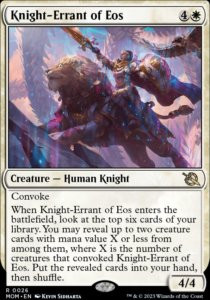 Knight-Errant of Eos, a powerful card advantage engine in Boros Convoke Pioneer
Knight-Errant of Eos, a powerful card advantage engine in Boros Convoke Pioneer
Deck Weaknesses: Achilles’ Heel
While Boros Convoke boasts significant strengths, it’s not invincible. Dedicated metagame strategies can effectively counter its game plan. Board wipes, in various forms, represent the deck’s most significant vulnerability.
Sweepers are prevalent across Pioneer’s color spectrum: White offers Temporary Lockdown, Depopulate, and Farewell. Red brings Brotherhood’s End and End the Festivities. Black has access to Ritual of Soot, Extinction Event, and Languish. Multicolor options like Supreme Verdict and Hidetsugu Consumes All further expand the sweeper arsenal. Even Mono-Green, not traditionally known for creature removal, can access The Filigree Sylex via Karn’s wishboard.
Playing around sweepers is challenging. Sometimes, accepting losses to these effects is part of playing a linear, aggressive deck. However, not all sweepers are created equal. Mana value or toughness differences can allow some creatures to survive, enabling you to rebuild quickly and capitalize on remaining resources. Boros Convoke’s ability to generate multiple creatures per card facilitates rapid recovery after board wipes.
Another inherent risk is the deck’s focus on its own game plan. Interaction with opponent’s strategies is limited. If you stumble or face a fast combo deck, disruption options are scarce. Cards like Giant Killer and sideboard choices offer some interaction, but comprehensive board control is not the deck’s strength. However, a turn two Venerated Loxodon can sometimes serve as a surprising answer to a wide range of threats by creating a large blocker.
Boros Convoke – Card-by-Card Analysis
Boros Convoke is a prime example of a synergistic linear deck. Individually, many cards appear weak, but combined, they fuel powerful payoffs and create overwhelming advantages. We can categorize the maindeck cards into three core groups: Enablers, Payoffs, and Flex Slots.
Enablers: Fueling the Convoke Engine
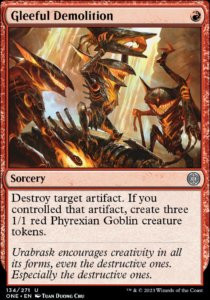 Gleeful Demolition, the cornerstone of Boros Convoke's explosive starts
Gleeful Demolition, the cornerstone of Boros Convoke's explosive starts
This card is the linchpin of the entire archetype. Without Gleeful Demolition, Boros Convoke wouldn’t exist in its current form. The deck is specifically built to maximize its potential, and the payoff is immense.
A turn one play of Voldaren Epicure or Thraben Inspector into a turn two Demolition followed by a Convoke spell is incredibly powerful and difficult to disrupt. Instant-speed artifact removal is not widely played in Pioneer, making this sequence surprisingly consistent.
Another potent opening is turn one Ornithopter into Demolition, leading to a turn two Invasion of Gobakhan flip on the same turn. This early snowball effect is devastatingly fast.
Gleeful Demolition also synergizes exceptionally well with Reckless Bushwhacker, generating a large number of creatures to pump for lethal attacks. And remember its utility mode – it can destroy opposing artifacts, providing unexpected versatility.
Thraben Inspector and Voldaren Epicure
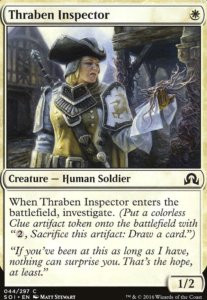 Thraben Inspector, a versatile one-mana creature and artifact producer
Thraben Inspector, a versatile one-mana creature and artifact producer
These one-mana creatures serve a similar primary function in Boros Convoke: they provide an early body and create an artifact token for Gleeful Demolition. They also represent mana-neutral plays when casting Convoke spells.
Thraben Inspector is generally slightly superior. It’s a white creature (relevant for Convoke), has two toughness, and its Clue token offers more versatile card draw later in the game. Voldaren Epicure‘s edge lies in race situations, where its enter-the-battlefield damage trigger can be crucial.
Don’t underestimate the utility of Clue and Blood tokens beyond being sacrificed to Demolition. In the mid-game, they can provide valuable card selection to find key spells.
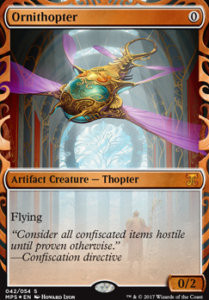 Ornithopter, the zero-mana flyer that powers up Convoke starts
Ornithopter, the zero-mana flyer that powers up Convoke starts
This unassuming 0/2 flyer is a surprisingly potent enabler. As a zero-mana creature, it acts as virtual “mana” for Convoke spells, especially valuable when opponents attempt to disrupt early threats. Its flying ability allows for chip damage in board stalls and becomes significant when pumped by Reckless Bushwhacker.
Ornithopter is an excellent Gleeful Demolition target, especially on turn one, enabling explosive starts. Be mindful of timing – responding to Demolition with removal fizzles the spell.
Crucially, Ornithopter enables Surge for Reckless Bushwhacker on turn two with just two mana. Its free cost and potential for later utility make it advisable to hold onto Ornithopters unless immediately beneficial.
“Two Mana, Get Two 1/1s” – Token Generators
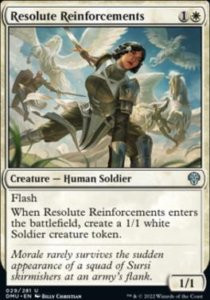 Resolute Reinforcements, a flash token generator for Boros Convoke Pioneer
Resolute Reinforcements, a flash token generator for Boros Convoke Pioneer
These two-mana spells are a reliable source of early creatures, fueling Convoke payoffs. They are effective against point removal, as opponents struggle to efficiently trade one-for-one. In Convoke turns, they are mana-neutral. The optimal number of these effects in the deck is still debated. Lists vary from three to eight copies. Currently, six copies feel optimal, but this is subject to further refinement.
Resolute Reinforcements and Forbidden Friendship are the premier choices in this category due to their superior power. Both generate a white creature, contributing to five-mana Convoke costs and relevant color synergy. This is especially useful with Forbidden Friendship when white mana from lands is scarce – a rare but possible scenario.
Resolute Reinforcements’ flash aspect is valuable for playing around sweepers and surprising opponents with lethal attacks. Forbidden Friendship stands out as the only card of this type creating a token with haste. This haste effect is exceptionally powerful in Boros Convoke, outweighing its inability to be fetched by Knight-Errant.
Other options exist, but are less frequently played. Servo Exhibition creates two artifact 1/1s, providing additional Gleeful Demolition fuel. However, destroying non-creature artifacts or creatures without power is generally preferred. Like Forbidden Friendship, it can’t be fetched by Knight-Errant. Goblin Instigator circumvents this fetch restriction, but its vanilla tokens lack relevant abilities, colors, or types. It becomes a more defensible option in Burning-Tree Emissary builds due to its red mana cost and creature type.
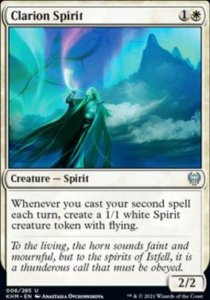 Clarion Spirit, a conditional token generator with a high ceiling
Clarion Spirit, a conditional token generator with a high ceiling
Clarion Spirit shares the two-mana cost and creature generation theme but operates differently. It has a lower floor and a higher ceiling compared to the “two mana, get two 1/1s” cards. If removed immediately, Clarion Spirit provides no immediate value. However, if it survives to trigger even once, it generates a flying token and pulls ahead in value. Multiple triggers can quickly become overwhelming, often leading to decisive advantages unless a sweeper intervenes.
The optimal inclusion of Clarion Spirit remains under evaluation. While alternatives haven’t proven compelling, further exploration of two-drops or increased one-drop density is ongoing. The archetype’s evolution may lead to a different two-mana creature or a shift in mana curve altogether.
Burning-Tree Emissary: A Divisive Inclusion
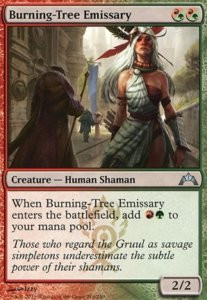 Burning-Tree Emissary, a high-risk, high-reward two-drop for Boros Convoke
Burning-Tree Emissary, a high-risk, high-reward two-drop for Boros Convoke
The inclusion of Burning-Tree Emissary is a key point of divergence among Boros Convoke builds. The community is divided, with some players advocating for its inclusion and others, including myself, remaining skeptical. Let’s analyze its pros and cons for the deck.
Pros:
- Synergy with Reckless Bushwhacker: Burning-Tree Emissary excels at enabling early Reckless Bushwhacker plays, creating explosive damage potential.
- Accelerated Development: The mana generated can facilitate faster board development, allowing for quicker deployment of threats.
Cons:
- Incompatibility with Jegantha: Burning-Tree Emissary prevents the use of Jegantha, the Wellspring as a companion, sacrificing a potential free resource.
- Mana Utilization Challenges: Effectively utilizing the generated mana can be restrictive. In many Boros Convoke lists, it primarily casts Reckless Bushwhacker, Forbidden Friendship, and one-mana spells. It doesn’t directly contribute to casting two-mana white spells or Convoke spells without existing white creatures. Adjusting the two-mana enabler suite to better support Burning-Tree Emissary often leads to playing less efficient token generators than Resolute Reinforcements.
- Mediocre Standalone Card: Burning-Tree Emissary alone is a two-mana creature that only produces a single body. As a topdeck without immediate follow-up, or when mana generation is irrelevant, it underperforms.
Overall, Burning-Tree Emissary is a high-variance card. It shines in optimal scenarios but falters when plans deviate. Historically, aggressive combo strategies initially prioritized maximizing explosive starts. However, experience has shown that consistency and resilience in less ideal draws are often more crucial for sustained success. This is why, currently, I favor Clarion Spirit over Burning-Tree Emissary. Focusing on improving average draws rather than solely amplifying best-case scenarios seems more strategically sound. Ultimately, Burning-Tree Emissary is a two-mana investment that only yields one body, offering limited contribution to the “go wide” strategy or setting up for Convoke payoffs unless immediately followed by Reckless Bushwhacker. Time and continued testing will determine the optimal approach.
Payoffs: Converting Board Presence into Victory
Convokers: Venerated Loxodon and Knight-Errant of Eos
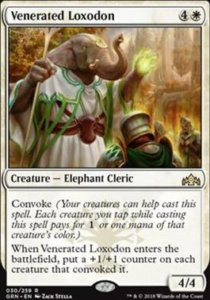 Venerated Loxodon, a powerful pump spell and board presence enhancer
Venerated Loxodon, a powerful pump spell and board presence enhancer
Venerated Loxodon and Knight-Errant of Eos serve as the primary payoff cards, converting wide board states into tangible advantages. They transform early creature investments into either increased board power or card advantage, setting up future threats.
The ideal scenario is casting a Convoker on turn two, with turn three being a consistently achievable target even against some disruption. Hands lacking a clear path to a turn three Convoker should generally be mulliganed.
Choosing between Venerated Loxodon and Knight-Errant of Eos depends on the matchup and game state. Venerated Loxodon is preferred for immediate damage and overwhelming blockers. Knight-Errant of Eos is more valuable against removal-heavy decks or when card advantage is paramount. Starting with Knight-Errant can lead to casting more Convokers in subsequent turns.
Knight-Errant’s effectiveness scales directly with the number of creatures used to Convoke it. Maximizing creatures for convoke amplifies its value. Convoking with only creatures is ideal, enabling fetching more Convokers and creating a chain reaction. Convoking with at least three creatures guarantees fetching Reckless Bushwhacker, a crucial threat.
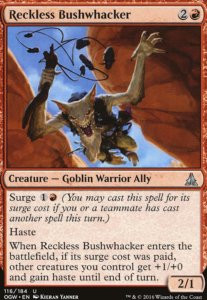 Reckless Bushwhacker, the game-ending pump spell for Boros Convoke
Reckless Bushwhacker, the game-ending pump spell for Boros Convoke
Reckless Bushwhacker is the primary damage payoff, capitalizing on wide board states. Ideally, cast it with Surge when your board threatens lethal damage. However, in desperate situations, a turn two Bushwhacker with Ornithopter can set up a turn three Convoker. This line should be reserved as a last resort.
The haste-granting ability allows for immediate counterattacks after sweepers. Always aim to hold a cheap spell (ideally Ornithopter or a one-drop) to enable Surge when topdecking Reckless Bushwhacker.
Consider siding out one copy of Reckless Bushwhacker in slower matchups where its raw speed is less critical. Multiple Bushwhackers in the opening hand can be clunky and hinder Convoker deployment. Despite this, its impactful nature warrants its inclusion, and it remains a potent draw or Knight-Errant target.
Flex Slots: Customizable Utility
Boros Convoke’s core strategy is well-defined, but the remaining slots offer flexibility. Finding optimal cards for these slots is ongoing, with numerous options tested and more to explore. The ideal flex slot card should be:
- Cheap: One-mana cards are preferred to maintain a smooth curve.
- Synergistic: Creatures are favored for Knight-Errant synergy; cards interacting with the board state are highly valued.
- Impactful in Multiple Stages: Relevant in both early and late game, offering utility when fetched by Knight-Errant.
 Giant Killer, a versatile flex slot card offering early presence and removal
Giant Killer, a versatile flex slot card offering early presence and removal
Currently, Giant Killer is the top contender for flex slots. Its versatility is unmatched. As a one-mana white creature, it contributes to both board presence and Convoke. In the mid-game, it functions as removal for larger creatures or as a tapper, useful against lifelink threats like Atraxa.
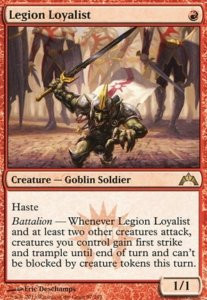 Legion Loyalist, a situational one-drop with combat trick potential
Legion Loyalist, a situational one-drop with combat trick potential
Legion Loyalist is a one-drop with a potentially relevant mid-game ability. However, its effectiveness is highly situational. It can swing combat math in specific scenarios but be irrelevant in others. Often, it functions as a vanilla 1/1 with haste, underwhelming by Pioneer standards. It may be valuable in creature-heavy metagames, but its narrow impact limits broader appeal.
 Legion's Landing, a transformative land with lifelink token generation
Legion's Landing, a transformative land with lifelink token generation
Legion’s Landing has proponents, but skepticism remains. As a non-creature spell, it inherently lags behind creature-based flex options. Its upside is generating a white lifelink token, combining relevant keywords and color. However, the transformed side, Adanto, the First Fort, is less appealing. Attacking with three creatures to flip it and then spending four mana for a 1/1 token feels clunky. In creature-light matchups, it can become a free mana source. But against established defenses or when Convoke spells are preferred, attacking and then investing four mana for a 1/1 is inefficient. While its potential exists, its awkwardness makes it less desirable.
 Skrelv, Defector Mite, a protective artifact creature with evasion
Skrelv, Defector Mite, a protective artifact creature with evasion
Skrelv, Defector Mite is a one-mana white artifact creature, a promising start. Its ability to push damage through board stalls and protect key creatures like Convokers or Clarion Spirit from removal is valuable. However, its impact wanes when drawn late or fetched by Knight-Errant, as its 1/1 body is less impactful and it lacks blocking capabilities. Its protection ability is also ineffective against sweepers, the deck’s primary weakness. Skrelv, Defector Mite is a consideration, but its limited late-game impact is a drawback.
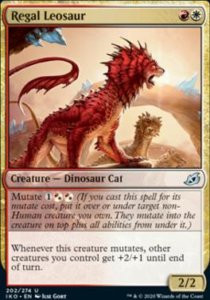 Regal Leosaur, an additional pump effect, but potentially redundant
Regal Leosaur, an additional pump effect, but potentially redundant
Regal Leosaur functions as extra copies of Reckless Bushwhacker. While theoretically sound, redundancy in this effect may be unnecessary. With four Bushwhackers and four Knights to fetch them, finding pump effects is generally not an issue. Regal Leosaur‘s major downside compared to Bushwhacker is the lack of a pump effect if removed in response. It could be a one-of or a sideboard option against non-interactive decks that deploy large threats and lack removal, such as Green Devotion.
 Halo Hopper, a conditional Convoke spell with limited utility
Halo Hopper, a conditional Convoke spell with limited utility
Halo Hopper is too expensive to be an enabler and too weak to be a primary payoff. Its best-case scenario is following a turn one Ornithopter into Gleeful Demolition, creating a 3/2 attacker for tempo advantage. It can also be cast on turn two with a one-drop and token generators. However, with eight Convoke spells already present, adding more can lead to clunky draws. Multiple copies are undesirable, as “flood the board” scenarios prioritize attacking before defenses are established. Tapping three creatures for a 3/2 is often inefficient. A single copy might be considered, but skepticism remains.
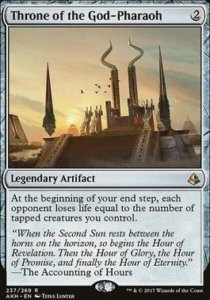 Throne of the God-Pharaoh, a potential win condition in board stalls, but untested
Throne of the God-Pharaoh, a potential win condition in board stalls, but untested
Throne of the God-Pharaoh offers a unique win condition in board stall situations. Its effectiveness remains unproven through testing.
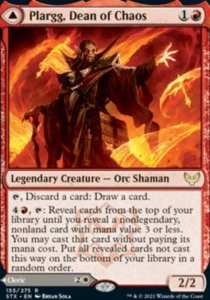 Plargg, Dean of Chaos, an underperforming flex slot option
Plargg, Dean of Chaos, an underperforming flex slot option
Avoid Plargg, Dean of Chaos. Regal Leosaur is a significantly superior alternative.
The Manabase: Consistent Color and Untapped Lands
Boros Convoke often operates on low land counts, necessitating efficient mana sources. Lands should:
- Enter the battlefield untapped consistently.
- Produce both red and white mana for smooth curving.
Sacred Foundry, Inspiring Vantage, and Battlefield Forge are essential, fulfilling both criteria. Maximize their inclusion. Mana Confluence provides flexible mana, but its life loss cost is significant, especially in aggressive matchups. One or two copies are acceptable for color fixing, but higher counts are not recommended.
Given the red-heavy manabase, increasing white sources from fourteen to fifteen is advisable. Needleverge Pathway is the next best option for this purpose. This setup has proven effective for white mana consistency, but future refinements are possible.
 Castle Embereth, a powerful land-based pump effect for Boros Convoke
Castle Embereth, a powerful land-based pump effect for Boros Convoke
With fifteen white sources secured, the remaining land count is crucial. Initial builds ran seventeen lands, which proved insufficient. Increasing to eighteen, even with Legion’s Landing, still felt lacking. These extra slots were initially explored with creatures like Regal Leosaur, but mana constraints hindered their effectiveness. Shefet Dunes was considered for a late-game anthem effect, but reaching five lands with eighteen lands was inconsistent.
Castle Embereth emerged as a superior option. Requiring only four lands to activate and offering reusable anthem effects without sacrifice, it provides significant late-game reach. Its tapped entry was mitigated by shifting it to a “spell slot” and adding Mountains to improve untapped chances. Increasing the land count to twenty, including two Castles, has proven optimal.
While the manabase is generally effective, draws with only red sources and white spells can occur. This is the trade-off for Castle Embereth‘s powerful anthem effect, a worthwhile exchange in most scenarios. Other utility lands like Sokenzan, Crucible of Defiance, Den of the Bugbear, and Shefet Dunes exist, but Castle Embereth‘s power level surpasses them.
Sideboard Options: Adapting to the Metagame
The sideboard is the most actively developing aspect of Boros Convoke. While some cards are likely staples, significant room for optimization remains. Expect sideboard compositions to evolve in the coming weeks. Instead of a definitive sideboard guide, consider these insights into individual card choices and their roles:
Frontrunners: Core Sideboard Staples
If Burning-Tree Emissary is excluded from the maindeck, Jegantha, the Wellspring becomes a valuable companion. While infrequent in games, a free extra resource is generally beneficial. It can serve as a vanilla 5/5 or discard fodder for Blood tokens.
 Rending Volley, efficient removal against creature-heavy strategies
Rending Volley, efficient removal against creature-heavy strategies
Rending Volley is a highly likely sideboard staple. It’s efficient removal against popular Pioneer decks like Humans, Spirits, and Greasefang, as well as niche strategies like Angels, Auras, and Rona combo. Up to four copies are justifiable, although sideboard space can be limiting.
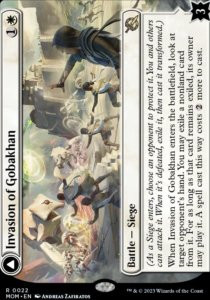 Invasion of Gobakhan, disruption and a long-term threat in one
Invasion of Gobakhan, disruption and a long-term threat in one
Pioneer sweepers vary significantly, making a universal answer challenging. Countermagic and discard are ideal, but Invasion of Gobakhan is the closest Boros equivalent. It provides information, delays key opponent cards (often early-game enablers), and, when flipped, becomes a persistent threat and protection against some sweepers.
Invasion of Gobakhan can be awkward on the draw, as the two-mana investment can hinder early creature deployment. However, it’s the best available tool for disruption. On the play, turn one Ornithopter + Gleeful Demolition into Invasion can be game-winning against removal-heavy decks.
Current lists often run three copies, but numbers may fluctuate based on metagame shifts and the prevalence of Convoke hate. Less diverse hate cards might lead to more specialized, efficient answers, while broad-spectrum tools like Invasion remain relevant against varied threats.
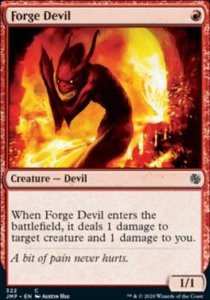 Forge Devil, tempo-focused removal against small creatures
Forge Devil, tempo-focused removal against small creatures
Forge Devil is ideal against tempo-oriented opponents playing x/1 creatures in the early game. Its primary targets are Llanowar Elves and x/1 human one-drops like Recruitment Officer. It excels on the draw, where tempo advantage is critical. Zero to three copies are viable depending on the expected frequency of Devotion and Humans matchups.
 End the Festivities, mirror match removal for Boros Convoke
End the Festivities, mirror match removal for Boros Convoke
While similar to Forge Devil, End the Festivities is primarily a mirror match tech. It can be awkward if opponents lead with Gleeful Demolition into Venerated Loxodon, but often kills multiple creatures for one mana in mirror matches. It can also be effective against Humans or Llanowar Elves decks, though Forge Devil is generally preferred in those matchups.
Possible Additions: Exploring Niche Techs
Pithing Needle is a cheap artifact that disrupts various strategies. Key targets include Karn, the Great Creator or Polukranos, Reborn against Mono-Green, and combo pieces like Thespian Stage (Lotus Combo) or Rona, Herald of Invasion (Rona Combo). Against UW Control, it can name The Wandering Emperor or Teferi, Hero of Dominaria. A single copy is often valuable, with quantities ranging from zero to three depending on metagame needs.
If red sweepers like Brotherhood’s End or Deafening Clarion become prevalent anti-Convoke tools, Surge of Salvation offers a direct counter.
Tormod’s Crypt‘s primary strength is its zero-mana artifact status, synergizing with Gleeful Demolition. However, its narrow graveyard hate is often less impactful than other sideboard options. Its best application is against Greasefang, but Rending Volley is generally a more versatile answer.
Wedding Announcement is a powerful card, but its fit in Boros Convoke is debated. Initially sideboarded heavily, its inclusion has decreased. While it offers grind potential against RB Midrange, even in that matchup, its turn three slot often competes with Convokers. Its future in the archetype is uncertain.
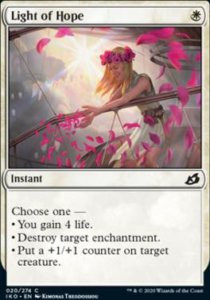 Light of Hope, narrow but effective enchantment removal
Light of Hope, narrow but effective enchantment removal
Light of Hope exemplifies narrow but effective answers to specific threats, particularly Temporary Lockdown. Using it in response to Lockdown’s exile trigger prevents exile, saving tokens. It also addresses problematic enchantments like Enigmatic Incarnation. Light of Hope is currently favored over Wear//Tear due to its modality and the relative scarcity of impactful artifacts to destroy.
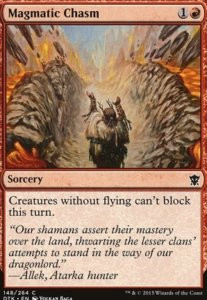 Magmatic Chasm, a potential answer to board stalls in the mirror match
Magmatic Chasm, a potential answer to board stalls in the mirror match
In early Boros Convoke iterations, Magmatic Chasm was used to break board stalls. Regal Leosaur is now generally preferred for this role. However, Magmatic Chasm may still have merit in mirror matches where board states become locked, and early Venerated Loxodon plays are absent. Further testing is needed to assess its viability.
Gameplay: Mastering Boros Convoke’s Nuances
Boros Convoke is a linear deck with a consistent core strategy: flood the board with cheap creatures and leverage them for powerful Convoke payoffs or Reckless Bushwhacker attacks. While the individual cards may seem weak in isolation, their synergy and critical mass create overwhelming advantages.
Sequencing and maximizing incremental damage or Convoke efficiency are crucial for success. While turn two Gleeful Demolition into Convoke sequences can feel like autopilot, most games require navigating complex decision trees. Goldfishing practice is recommended to internalize key lines of play. Here are three common opening scenarios:
Possible Goldfish Scenarios
1/1 Aggro Swarm
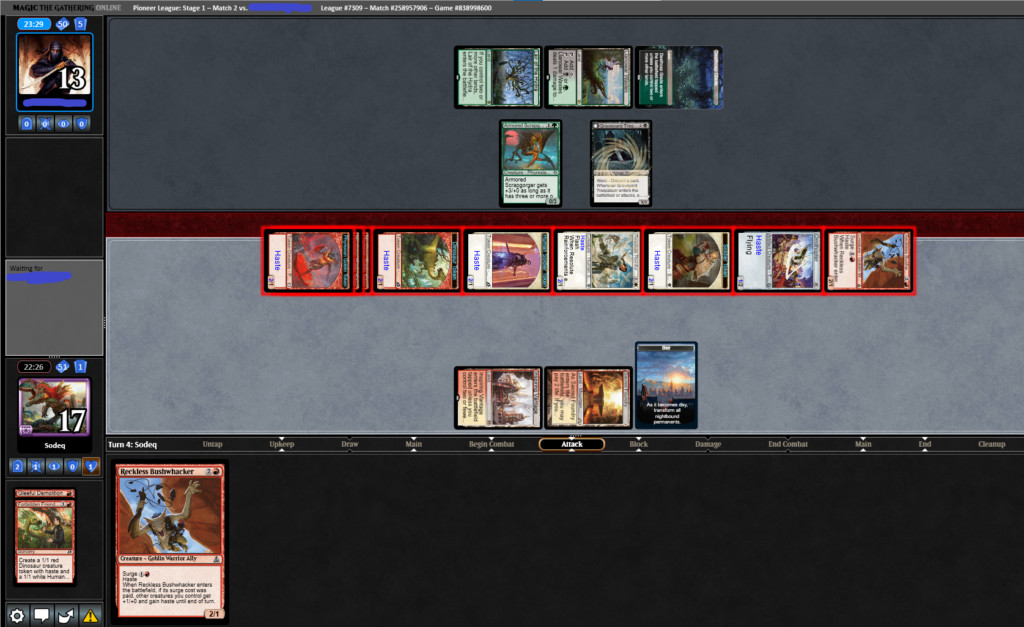 Boros Convoke Pioneer super wide board state
Boros Convoke Pioneer super wide board state
This straightforward approach focuses on casting enablers, attacking aggressively with all creatures, and overwhelming opponents through sheer numbers. Ideal starts involve early [Gleeful Demolition](https://deckbox.org/mtg/Gleeful Demolition) (ideally turn one with Ornithopter) followed by “create two 1/1s” effects. Effective against decks reliant on one-for-one removal and lacking blockers. Struggles against multiple blockers until critical mass is achieved. Reckless Bushwhacker is essential for pushing through final damage.
Knight-Errant into Bushwhacker
This plan is more intricate and setup-dependent. The goal is to deploy Knight-Errant of Eos and build incremental advantage, culminating in lethal attacks. It’s more fragile than fast Venerated Loxodon starts due to the creature count reliance. Venerated Loxodon is less sensitive to creature numbers, as early casting is paramount. Knight-Errant’s trigger power directly scales with Convoke creatures; maximizing creature count is crucial. The difference between four and five creatures is significant. Convoking with five creatures early enables fetching any creature, including more Knights for snowballing advantage.
Deciding whether to attack with an existing 4/4 Knight or Convoke it for X=5 is matchup-dependent. Longer games favor finding Reckless Bushwhacker for lethal attacks over another Convoker. Tapping three creatures to cast Knight and Surge Bushwhacker in the same turn is a common and powerful play, sacrificing some early damage for a hasty 5/4 threat.
Fast Loxodon Aggression
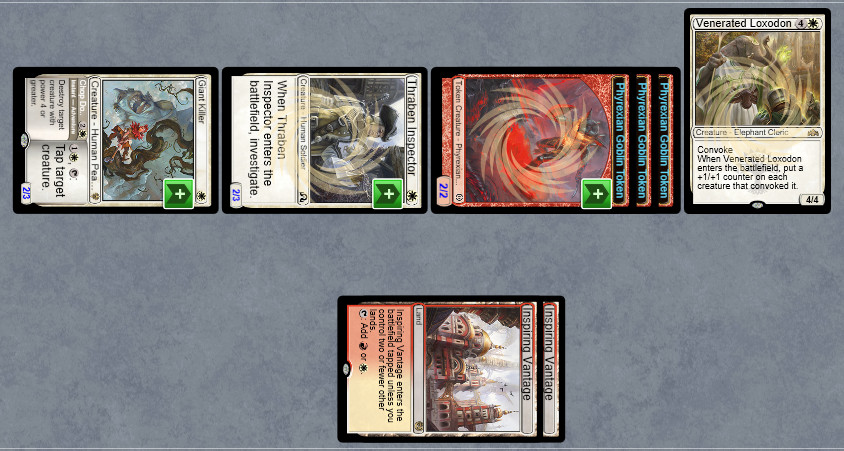 Boros Convoke Pioneer fast Loxodon board state
Boros Convoke Pioneer fast Loxodon board state
This is often the preferred line. Focus on early creature deployment and pumping them with Venerated Loxodon. Record-breaking starts can achieve sixteen power on turn two (T1 Ornithopter Gleeful Demolition, T2 Thraben Inspector, Demolition, Venerated Loxodon). Once established, relentless attacks often lead to swift victories. Simpler and less conditional than Knight-Errant lines.
Keep or Mulligan: Hand Evaluation Guide
Boros Convoke’s linear nature simplifies mulligan decisions. Hands with two or more lands and early token generation are generally keeps. Mulliganing for a Convoker specifically is not recommended; average hands with potential turn three Convokes are competitive against most of the format.
One-lander keeps are situational, requiring Gleeful Demolition, at least two of Thraben Inspector (preferred) or Voldaren Epicure, and a Convoker. These hands are rare but powerful keeps, not mulligans.
Here are example hands illustrating keep/mulligan guidelines:
Perfect Hand
Turn two fourteen power potential is ideal, achievable via T1 Ornithopter + Gleeful Demolition into T2 Forbidden Friendship or T1 Thraben Inspector into T2 Demolition, Ornithopter.
Solid Hands
 Boros Convoke Pioneer Solid Hand 1Guaranteed turn three Knight-Errant of Eos + Castle Embereth for mid-game reach. Artifact producers enhance Gleeful Demolition topdeck potential.
Boros Convoke Pioneer Solid Hand 1Guaranteed turn three Knight-Errant of Eos + Castle Embereth for mid-game reach. Artifact producers enhance Gleeful Demolition topdeck potential.
 Boros Convoke Pioneer Solid Hand 2Another solid turn three Knight. Third land is lacking, making removal on early creatures potentially disruptive.
Boros Convoke Pioneer Solid Hand 2Another solid turn three Knight. Third land is lacking, making removal on early creatures potentially disruptive.
 Boros Convoke Pioneer Solid Hand 3Ten power on turn two with potential for more with cheap creature topdecks.
Boros Convoke Pioneer Solid Hand 3Ten power on turn two with potential for more with cheap creature topdecks.
 Boros Convoke Pioneer Solid Hand 4Manabase is suboptimal, but still a solid keep. Pathway into Inspector start is best. Red source topdeck perfect, otherwise solid T3 Venerated Loxodon.
Boros Convoke Pioneer Solid Hand 4Manabase is suboptimal, but still a solid keep. Pathway into Inspector start is best. Red source topdeck perfect, otherwise solid T3 Venerated Loxodon.
 Boros Convoke Pioneer Solid Hand 4For Burning-Tree Emissary builds – Convoker-less, but still strong. Burning-Tree Emissary into Reckless Bushwhacker on turn three or four results in twenty-two damage by turn four.
Boros Convoke Pioneer Solid Hand 4For Burning-Tree Emissary builds – Convoker-less, but still strong. Burning-Tree Emissary into Reckless Bushwhacker on turn three or four results in twenty-two damage by turn four.
 Boros Convoke Pioneer Solid Hand 4Turn one Ornithopter + Gleeful Demolition, turn two Invasion of Gobakhan, and more creatures on turn three. Devastating against removal-heavy decks.
Boros Convoke Pioneer Solid Hand 4Turn one Ornithopter + Gleeful Demolition, turn two Invasion of Gobakhan, and more creatures on turn three. Devastating against removal-heavy decks.
Hands That Are Fine, But Not Spectacular
 Boros Convoke Pioneer Solid Hand 2Solid curve, but Convoker-less. Clarion Spirit improves hand value if opponent lacks removal. Turn two Clarion Spirit into immediate Ornithopter or next turn Forbidden Friendship + Ornithopter or Ornithopter + Reckless Bushwhacker can flood the board quickly.
Boros Convoke Pioneer Solid Hand 2Solid curve, but Convoker-less. Clarion Spirit improves hand value if opponent lacks removal. Turn two Clarion Spirit into immediate Ornithopter or next turn Forbidden Friendship + Ornithopter or Ornithopter + Reckless Bushwhacker can flood the board quickly.
 Boros Convoke Pioneer Solid Hand 2Solid curve, Convoker-less. Good for 1/1 aggro, good topdecks.
Boros Convoke Pioneer Solid Hand 2Solid curve, Convoker-less. Good for 1/1 aggro, good topdecks.
 Boros Convoke Pioneer Okay Hand 3Convoker-less, four lands already in hand are drawbacks, but Castle Embereth saves it.
Boros Convoke Pioneer Okay Hand 3Convoker-less, four lands already in hand are drawbacks, but Castle Embereth saves it.
Traps – Mulligan These Hands
 Boros Convoke Pioneer Trap Hand 1Looks good initially, but lacks artifact producers for Gleeful Demolition. Easy mulligan.
Boros Convoke Pioneer Trap Hand 1Looks good initially, but lacks artifact producers for Gleeful Demolition. Easy mulligan.
 Boros Convoke Pioneer Trap Hand 1Reckless Bushwhacker is not an enabler. Keep if Bushwhacker was any one or two mana creature.
Boros Convoke Pioneer Trap Hand 1Reckless Bushwhacker is not an enabler. Keep if Bushwhacker was any one or two mana creature.
Random Tips for Boros Convoke Pioneer
- Don’t hesitate to attack wide boards of 1/1s into a single blocker. Trading a token for 5+ damage is often worthwhile, setting up lethal Reckless Bushwhacker finishes. Even without Bushwhacker, keep generating tokens to overwhelm defenses.
- Against expected removal, and with three creatures, two lands, Resolute Reinforcements, and a Convoker, prioritize early Convoke by tapping two lands. Mana-neutral 1/1s are good, but securing a 4/4 safely is sometimes better than maximizing Convoke value.
- [Gleeful Demolition](https://deckbox.org/mtg/Gleeful Demolition) destroys opposing artifacts!
- Reckless Bushwhacker can be cast for three mana if Surge is not achievable.
- Forge Devil‘s ability is mandatory; avoid playing it on an empty board unless self-destruction is desired.
- When sequencing early creatures, double-check mana constraints to avoid bottlenecks. With Mountain, Inspiring Vantage, two Thraben Inspector, and Voldaren Epicure, start with an Inspector.
- Against Make Disappear, slow-roll Convokers and prioritize enablers. If they resolve, Convokers can be cast without land mana, saving mana for Disappear costs.
BONUS: Sample Boros Convoke Pioneer Decklist and Mini Sideboard Guide
For those playing in upcoming events, here’s a sample decklist and mini sideboard guide. This is a current iteration and may evolve. A full sideboard guide is planned for next week.
Decklist:
**Creatures (28)**
4 Ornithopter
4 Thraben Inspector
4 Voldaren Epicure
4 Clarion Spirit
4 Resolute Reinforcements
2 Forbidden Friendship
3 Giant Killer
3 Knight-Errant of Eos
**Spells (8)**
4 Gleeful Demolition
4 Reckless Bushwhacker
**Lands (24)**
4 Battlefield Forge
4 Inspiring Vantage
4 Mana Confluence
4 Needleverge Pathway
6 Mountain
2 Castle Embereth
**Sideboard (15)**
1 Jegantha, the Wellspring
3 Rending Volley
3 Invasion of Gobakhan
2 Forge Devil
2 End the Festivities
1 Pithing Needle
2 Wedding Announcement
1 Light of HopeMini Sideboard Guide:
RB Midrange
+2 Wedding Announcement
-1 Ornithopter -1 Forbidden Friendship
Mono Green
+2 Forge Devil +1 Pithing Needle
-1 Voldaren Epicure -1 Resolute Reinforcements -1 Giant Killer
UW Control
+3 Invasion of Gobakhan +1 Pithing Needle +1 Light of Hope (only if they have Temporary Lockdowns)
-1 Giant Killer -1 Venerated Loxodon -1 Ornithopter P: -1 Voldaren Epicure D: -1 Ornithopter
if you also side in Light of Hope: -1 Ornithopter
Abzan Greasefang
+3 Rending Volley +1 Pithing Needle
-1 Clarion Spirit -1 Forbidden Friendship -1 Giant Killer -1 Voldaren Epicure
Humans
+3 Rending Volley +2 Forge Devil
-2 Giant Killer -2 Forbidden Friendship -1 Reckless Bushwhacker
(Maybe Wedding Announcement on the play could be good, but I haven’t tested it yet. You can also try to surprise the opponent with End the Festivities, but once the opponent knows you have it, it’s easy to play around with their counters)
Incarnation
+3 Invasion of Gobakhan +1 Light of Hope
-1 Giant Killer -1 Forbidden Friendship -1 Reckless Bushwhacker P: -1 Voldaren Epicure D: -1 Ornithopter
Boros Convoke
+2 End the Festivities P: +2 Wedding Announcement D: +2 Forge Devil
-3 Giant Killer -1 Reckless Bushwhacker
(I’m not sure about extra play//draw effects to be honest since both options are not the best ones, but I haven’t found any better plan and Giant Killers are an easy side out anyway)
